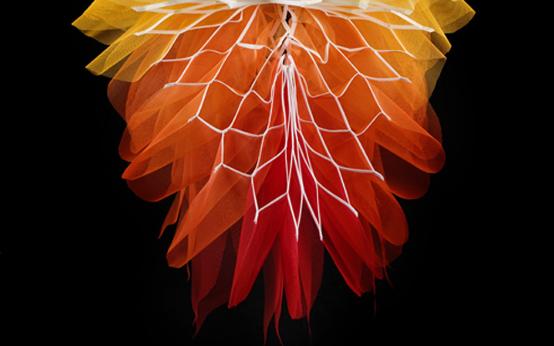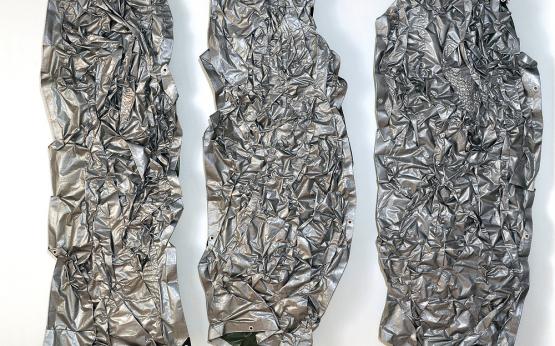Essays
To reflect on the exhibition, four essays have been penned by Anne Farren, Ann Schilo, Christiane Keller and Kirsten Hudson. These essays examine the concepts that lay behind Beyond Garment, and explore the meaning of fashion and materials from a variety of viewpoints.
Miss porcelain, 2009, by Kathryn Bell. Photo by Penny Lane
Model: Sarah Pauley @ Viviens Model Management. Photo copyright of WA Musuem.
Calculated Cracks in the Pedestal of Chic
I have an overwhelming paranoia of food getting trapped between my teeth. So great is this fear that I now have a notable collection of teeny-tiny mirrors stashed in secret compartments of every handbag I own, in the likelihood that I cannot control the obsessive urge to surreptitiously sneak a glance at my ever-questionable oral state. This is not an irrational terror born out of watching too much B-grade, chick-lit cinema. Instead, this ever-present fear of public ineptness is ingrained into my psyche, subsequent to countless years of continual oral faux pas. Spinach, peppercorns and the much-feared poppy seed are just some of the culprits on my hit list of shame. It got so bad a few years ago that I swore to forever deny myself the kaleidoscopic pleasure of coloured food. Taking the lead from my fussy-eater son, I confined myself to delicate, snowy shades of safety, consuming only white food for one month.
Creeping its way into my dreams, I often awake from nightmares that leave me in cold sweats. Breathing hard, I desperately search for some kind of visual residue to unlock the source of my horror. Gradually it comes to me. Whether a memory, a foretelling, or a decree, etched into my consciousness is the image of that lingering finger at the edge of someone’s mouth, followed by the deliberately pointed look at mine. Flailing in the dark, my hand leaps to my mouth as I frantically struggle to dislodge the guerilla morsel that has made its spiteful stand. I turn on the light and through blurry eyes peek into the mirror I keep at the side of the bed. Slowly my hearts sinks as I acknowledge that even in my dreams a new nemesis was able to sneakily breach the outskirts of my carefully constructed facade and is now on public display in my oral picket line of shame.

- Infinity Blossom III (Revolutions Series), 2010.
- Photo by Eva Fernandez
- Photo copyright of Eva Fernandez
Unfortunately, involuntary oral additions are not my only fashion faux pas. Ladders marching up House of Holland stockings, unruly threads fluttering flirtingly on a Dries Van Noten jacket, and even the mortifying incident of a single square of toilet paper prominently speared on the stiletto of my Jimmy Choo’s as I strutted across Star Anise one night indicate the dark depths of my fashion quagmire. Described as ‘an accident waiting to happen’ by my father and ‘simply tragic’ by my teenage sons, it seems, despite my superlative fashion intentions, I am always hindered by inadvertent ornamental discrepancies that reveal my less than noble origins. Socially suspect, my inability to achieve Pygmalion success thus marks me as ‘outsider’: a wannabe-fashionista who always seems to fall wretchedly short of fashion-savvy coolness. Despite my vigilantly assembled ensembles, these chance accessories elicit a myriad of murmurs, smirks and finger-pointing. Like the clue that leads to the unmasking of an impostor, I am inevitably deemed a fraud.
The unmasking of any imposter is a tricky state of affairs. Words like phony, scam and hoax are bandied about and there always seems to be a lot of rage from those who are convinced they’ve personally been deceived. The 1990 exposure of Milli Vanilli now qualifies as the cultural exemplar. But what happens when ornamental undoing is a deliberate intent? Or when carefully constructed facades are consciously sliced with shrewd acts of intervention?
Works in Beyond Garment from Lizzie Delfs, Trish Little, Leah Tarlo and my own sickly-sweet offering deliberately query the veneer of ‘fashion’ and as such are calculated cracks in the pedestal of chic. Drawing upon the definition of ‘accessory’ as ‘ornamental excess’, these works evoke the visceral; that is, of body and of bodily things. Operating as both construct and enabler of meaning that contain the myths and beliefs defining Western fashion culture, these works act as sensory and physical interfaces between the environment and the self. To be blunt, these works all visually aggravate, offering awkward, discomforting and antagonistic encounters with our narcissistic and superficial surface condition. Elizabeth, Trish, Leah and yours truly comment on the oft-scary coteries found in workplace politics, uneasy domestic relationships and the habitually conflicting relationships we have with ourselves.
Defying Western fashion norms of beauty and symmetry, the subtlety of Elizabeth’s Revolutions problematises the shifting and transitory power and politics inherent in the bitchy cliques and catty schemes of devious female workplace relations. Think Desperate Housewives, but in Armani Privé power suits and Manolo Blahnik stilettos. Disrupting and distorting familiar materials into unfamiliar sensual forms — à la the big hair, shoulder pads and ostentatious costume bling of Dynasty — Elizabeth intricately manipulates flyscreen into striking hive-like wall pieces implying the need for sharp and skilful dexterity when negotiating the hidden traps and judgments of underhanded office politics. Traditionally meant to keep out a variety of unwanted little nasties, these bold yet gorgeously feminine flyscreen sculptures suggest there is a sinister aesthetic filter at play that expertly winnows out the queen bees from the wannabes. Created with the canny ability to fold from two dimensions into three-dimensional protrusive forms, Elizabeth’s sculptures present a choice: to be a lively, unique individual defiantly taking up space; or submit to the flat, dull drudgery of clone-hood and be swallowed into the abyss. I mean, c’mon, who would choose to be Charlotte when they could be Samantha?
Obsessively collecting and hoarding fragments of everyday life, relics of stories and histories of bodies, Leah Tarlo ironically re-examines and re-values our relationship to those things we deem unfashionable and insignificant in our ever-shifting quest for acceptable identity. Specifically claiming space for a variety of broken doll parts, Leah evokes Courtney Love’s 1994 grunge anthem, which screams ‘I fake it so true, I am beyond fake’, questioning our inability to contain feminine representation in a single and authentic entity. By juxtaposing and giving value to objects rejected as broken and inferior, Leah situates feminine identity as a series of unruly and uncanny moments of irreconcilable contradiction, humorously constructing open-ended narratives that disrupt our expectations of what it means to be real.
Visualising a state of corporeal abandonment, Trish Little’s Tarp Triumvirate explores the never static, blurred boundaries of fashion classifications and the dichotomies that separate the latest craze from the undesirables. Like discarded skins, Trish’s tarps hold traces of their anonymous former owners, and like a rabbit caught in the headlights of a noxious SUV, the viewer is forced to question both the tarps’ mundane function and their right to be publicly on show. Offering a critique on the culturally and socially sanctioned space of fashion, Trish seems to inquire as to whom and what is denied space and value in our ever-hopeful quest for the slickly new. Whom are we willing to walk over in our need to embody the hottest trends? Whom are we willing to use in our desire to personify the latest ‘fashion’? And whose cries for help do we ignore due to their inability to meet our socially and culturally defined standards of fashionable stylish acceptance? Dark and determined, these tarpaulins pose proud and tall, daring us to deny them their right to be there, audaciously taking up space.
Hanging silently from the ceiling like a glorified coathanger is my own self-indulgent contribution, titled dim — a self portrait. Created from fondant weighing 10.8 kilograms (the weight of skin and fat I am having strategically sculpted from my body), this flesh-coloured chandelier is designed to catch viewers’ attention only momentarily when it sporadically emits an annoying flicker. Pairing the body with pink sugar and ironically positioning it as simply another piece of domestic furniture — pretty, decorative but essentially empty — dim pokes fun at Western culture’s fashionable consumption of the female body as commodity and its position as the ultimate modern accessory. Drawing attention not only to the physical proportions that define fashion’s ideal body, but also the idea of fat being a hated, unwanted accessory, useless baggage long gone out of fashion, dim is a personal reminder of my own complicit stupidity in my utterly pitiless quest for acceptance.
Like my list of sadly tragic accidental accessories, the works by Elizabeth, Trish, Leah and, of course, little ol’ me, question the carefully constructed facades of an assortment of institutions and our ongoing relationships with them. However, instead of merely failing miserably to meet fashionable expectations, these works purposely use fashion as a site of antagonistic contestation, questioning the shifting material conditions of social status and class struggle, giving space to that which, more often than not, is pushed to the margins. Whether it is the carefully assembled guise we present to the world every day, the manner in which we negotiate tricky workplace relations, the glossy screen we construct to filter what happens behind the closed doors of our humble abode, or whom and what we turn a blind eye towards when they do not fit our aesthetic or social norms, these works consider the part we all play in the cover-ups, subterfuge and conspiracies of everyday life. They ask us to think beyond garment, beyond assumptions and beyond self, and instead to question and challenge homogenised forms of experience and monolithic versions of truth and value. Fashion, in this sense, functions as a language in which we can strategically ask difficult questions, ostensibly regarding how we find ourselves looking, or being looked at.
Author biography: Kirsten Hudson
Dr Kirsten Hudson is an artist-philosopher who is fascinated by how excessive historical and classical Western constructs of femininity can be redeployed to produce strategic and perverse female spectacles, ‘available through the most radical or quietest of acts’. Interested in questions regarding forms of female embodiment that allude to female invisibility, fragmentation and contradiction within Western culture, Hudson’s philosophical premise is that to ‘act like a woman’ is to embrace excessive historical and classical constructs of femininity as a means to demonstrate the artificiality and fiction of an authentic feminine identity.



